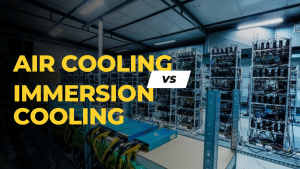Cooling systems play a crucial role in maintaining the performance and longevity of electronic devices. As technology advances, cooling options for electronic components have also progressed. Regarding cooling computers and other electronic equipment, there are two main options. Air cooling and immersion cooling. Air cooling was the primary cooling method for electronic devices for many years. However, with the evolution of immersion cooling, there is now an alternative option that may offer better results. Both methods have their benefits and drawbacks, and it’s essential to understand their differences before deciding. This article will explore the difference between the two and the best method for your specific needs.
Air Cooling: The Traditional Method
Air cooling is the most common cooling method used in electronic devices. It uses fans to circulate air within the device to remove heat. As the name suggests, the air removes heat from the computer or device. This method is simple, cost-effective, and easy to implement. However, air cooling has limitations, especially as the power density of devices increases. The right combination of fans and heatsinks is needed to ensure sufficient airflow to remove heat efficiently. Suppose the airflow is blocked or reduced due to clogged fans or dust accumulation. In that case, the device can overheat, leading to permanent damage.
One of the benefits of air cooling is that it is relatively inexpensive and easy to implement. Fans and heat sinks are readily available and can easily be installed on most devices. Additionally, air cooling tends to be quieter than immersion cooling, as fans can be tuned to run at lower speeds.
And the advantage of air cooling is its ease of use. It is a simple and effective cooling method for most standard electronic components. Additionally, air cooling is generally more affordable than immersion cooling. While air cooling is a popular cooling method, it has disadvantages. Air cooling is generally less effective at dissipating heat than immersion cooling. Additionally, air cooling may not be suitable for specific electronic components, as it may need to dissipate enough heat to keep them functioning correctly. However, air cooling has some drawbacks as well. For one, the air has a relatively low heat capacity, so it can only remove heat from a device at a specific rate. This means that high-powered devices may still overheat even with air cooling. Additionally, air cooling can lead to hot spots in the machine, where specific components are more desirable than others.
Pros:
- Cheaper and widely available
- Requires less power than immersion cooling
- Easy to maintain
Cons:
- Not as efficient at cooling as immersion cooling
- Airflow can cause issues with dust and debris
- Can create hot spots if the airflow is not properly managed
Advantages:
- Cheap and easy to install
- No risk of damaging the device due to immersion in liquids
- Easily replaceable if there are any problems
- Low maintenance
Disadvantages:
- Insufficient cooling for high-performance devices
- Limited by the ambient temperature of the environment
- Noisy due to the use of a fan
Immersion Cooling: The Alternative Method
Immersion cooling is a relative newcomer to the world of electronic cooling that is gaining popularity in data centers and high-performance computing applications. It involves submerging the device in a non-conductive liquid, such as mineral oil or engineered fluids, to remove heat from the device. The liquid is much more efficient at dissipating heat than air, keeping even high-powered computers cool. Immersion cooling is highly efficient, as the liquid directly contacts the device, providing uniform cooling across all components. It also eliminates the need for fans, as the fluid is circulated using a pump. This makes it a highly reliable and low-maintenance cooling method. One significant downside of immersion cooling is the cost. The initial investment in immersion cooling may be higher than in other air cooling methods. Additionally, some immersion cooling systems may require specialized maintenance, which could increase the overall cost. The main benefit of immersion cooling is that it is much more effective at removing heat than air cooling. Because the liquid is in direct contact with the device, it can quickly and efficiently release heat. Additionally, immersion cooling can eliminate hot spots, as the fluid evenly distributes the heat throughout the device.
The advantage of immersion cooling is its ability to transfer heat much more effectively than air cooling. Immersion cooling can also cool even the most challenging electronic components, such as high-performance CPUs and GPUs. Additionally, immersion cooling is a more eco-friendly solution, requiring less energy to cool electronic components. While immersion cooling is a newer and more efficient method of cooling, it does have its own set of disadvantages. Immersion cooling requires a more complex installation process and is generally more expensive than air cooling. Additionally, immersion cooling requires ongoing maintenance, as the liquid used in the cooling system must be monitored and replaced periodically.
However, there are some drawbacks to immersion cooling as well. For one, it generally requires more equipment and setup than air cooling. You will need a tank to hold the liquid and pumps and filters to circulate and clean the fluid. Additionally, immersion cooling tends to be similar to air cooling, as the pumps and fans required for the liquid system can be loud. However, immersion cooling comes with a higher initial cost and needs specialized infrastructure for its installation.
Pros:
- Much more efficient at cooling than air cooling.
- No issues with dust or debris.
- Can eliminate hot spots entirely.
Cons:
- More expensive than air cooling.
- Requires more power to run.
- Can be more challenging to maintain.
Advantages:
- High cooling efficiency, allowing for overclocking of high-performance devices.
- Low noise because there is no need for a fan.
- Device can operate at higher temperatures because coolant can be kept at a constant optimum temperature.
- Reduces the need for maintenance and replacement parts.
Disadvantages:
- Installation costs are higher because of the need for liquid coolant and a specialized container.
- Potential for leaks, which can damage the device.
- Device must be completely waterproofed.
- Difficult to modify once installed.
Which is best for your needs?
Choosing the suitable cooling method depends on the workload and the device’s size. Air cooling is more affordable and straightforward for most devices, making it ideal for most PC builders. If you have a low-powered device that doesn’t generate much heat, air cooling may be sufficient and cost-effective. However, immersion cooling may be better with a high-powered machine, such as a gaming PC or server. Immersion cooling can reduce the operating temperature of devices by up to 50 degrees Celsius, ensuring that the appliance operates optimally without overheating. Additionally, immersion cooling uses less energy than air cooling, saving costs over time. Immersion cooling is becoming increasingly popular in high-performance computing settings where liquid cooling is necessary to handle the extreme heat generated by the equipment.
Comparison:
While immersion cooling provides higher heat capacity and more efficient cooling is a relatively new technology that has yet to gain broader acceptance in the industry. This is partly due to its high cost and the challenge of managing the fluid. On the other hand, air cooling has been around for years and is a more affordable option. However, it’s worth noting that as computer systems grow more powerful and dense, air cooling becomes less efficient and more challenging to manage.
Conclusion
When it comes to cooling electronic equipment, there is no one-size-fits-all solution. Air and immersion cooling has benefits and drawbacks, and the best choice depends on your specific needs and preferences. You’ll need to weigh each method’s costs and benefits to decide which is right for you. It’s essential to consider factors such as the level of heat generated by the components, the price of the cooling system, and the level of maintenance required. While air cooling is a simple and effective method for most standard electronic components, immersion cooling may be necessary for high-performance parts that generate much heat. Ultimately, deciding which cooling method to use will depend on your needs and requirements. The goal is to ensure that your electronic devices operate optimally by keeping them cool and protected from heat-related damage.



